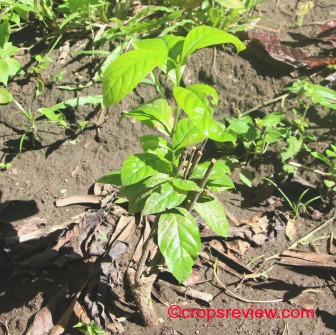Close to the end of August 2017 we uprooted coffee wildlings at Brgy. Datal Tampal in Malungon, Sarangani.
The 7-man expedition was launched to collect sufficient number of planting materials for direct planting at the Mindanao State University – Fatima Campus, General Santos City (MSU-GSC).
The roots were immediately pruned to allow potting into small plastic bags as about one-half of the collection was intended for possible replanting.
The shoots were cut to about a foot from root collar to ensure that water loss is minimal and so prevent dehydration until firmly established.
We deemed it proper for directly planted bareroot wildlings at the project site.
In addition, the shortening of the shoot was intended to promote emergence of multiple sprouts close to the ground.
This should allow the development of coffee trees with multiple trunks or broom-style branches which later will be trained to produce a dwarf foliage.
A short coffee tree can be advantageous as berries will be within easy reach during harvesting.
Farm Establishment With Bareroot Coffee Wildlings as Planting Materials
Bareroot coffee wildlings were directly planted on August 30, 2017, a day after arrival from plant collection expedition.
Because rainfall is scarce, ambient temperature is usually high, and the soil is sandy at MSU-GSC, the root collar was positioned below ground level and a shallow depression around the base of the plant was left to serve as water trap.
Application of plastic tent or bukot or kulob technique was also enjoined to trap and recycle the applied water inside.
Otherwise loss of water through evapotranspiration will be high.
If so, it may cause severe water deficit within the plant which can be fatal.
In addition, makeshift sheds made of coconut fronds were installed to avoid or at least minimize heat injury.
Bud break from the stems of coffee wildlings started one week after planting.
Coffee hills were spaced 2.5 m x 2.5 m apart (ground area = 5.5 m2 per tree) serving as intercrop to coconut spaced 12.5 m x 7.5 m (GA = 93.75 m2).
Although robusta coffee can be planted at 3 m x 3 m (GA = 9 m2) or 3.5 m x 3.5 m (GA = 12.25 m2), the narrowest distance was chosen mainly because the trees were intended to be trained to have short stature.
For coconut, the spacing of 12.5 m x 7.5 m instead of the recommended 8 m x 8 m spacing for dwarf variety was prompted by the limited number of seedlings and to fit into the revised planting layout.
Had there been a sufficient number of coconut seedlings, the original plan of 12.5 m x 5 m planting distance would have been pushed through.
This is equivalent to a ground area of 62.5 m2 per tree which is very close to that of 8 m x 8 m (GA = 64 m2).

Chili pepper was also planted between hills within each row.
Direct planting of seeds freshly extracted from ripe fruits was encouraged.
Twenty-two (22) seedlings of dwarf Catigan and 5 Tacunan coconuts donated by Dean Helen Perpetua of the College of Agriculture were planted on December 12, 2018.
These are variants of the Bilaka variety. The plants are now growing well.
Final update at 84 days after transplanting revealed that most of the planted coffee wildlings had developed multiple leaves.
Many of the chili peppers were also thriving well.
We named the project the “Coconut + Coffee + Chili Pepper Project.”
The plus sign (+) between two crops is a standard symbol that denotes intercropping or the simultaneous growth of the specified crops.
Although it’s too early to tell the outcome of this undertaking, I am glad we made it.
The training should have a lasting impression on those students of agriculture who loved to participate and sweat.
That in fact was the main objective of the exercise: to train them in plantation layout-making and in farm establishment.
Calculated Population Density
If grown as monocrop, the calculated (estimated) population densities in one hectare at the specified planting distance for both crops will be:
For Robusta coffee:
2.5 m x 2.5 m = 1,818
3.0 m x 3.0 m = 1,111
3.5 m x 3.5 m = 816
For dwarf coconut:
12.5 m x 7.5 m = 106
8 x 8 m = 156
Therefore, if a one-hectare farm is to be developed for coconut spaced 12.5 m x 7.5 m apart intercropped with coffee at a 2.5 m x 2.5 m distance, about 106 coconut seedlings will be needed.
For coffee wildlings, some 1,712 (i.e., 1,818 – 106 = 1,712) will be needed for planting assuming that survival rate is 100%.
The computed values, however, are mere estimates.
If precision is desired, it can be achieved by constructing a planting layout.
